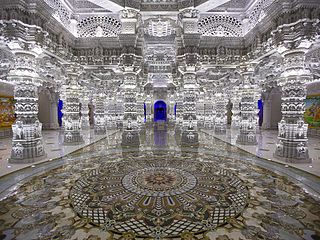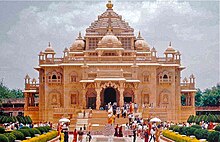
BAPS Shri Swaminarayan Mandir is a Hindu temple in Neasden, London. Built entirely using traditional methods and materials, the Swaminarayan mandir has been described as being Britain's first authentic Hindu temple. It was also Europe's first traditional Hindu stone temple, as distinct from converted secular buildings. It is a part of the Bochasanwasi Shri Akshar Purushottam Swaminarayan Sanstha (BAPS) organisation and was inaugurated in 1995 by Pramukh Swami Maharaj.

Bochasanwasi Akshar Purushottam Sanstha (BAPS), is a Hindu denomination within the Swaminarayan branch of Hinduism. It was formed, by Yagnapurushdas, on the principle that Swaminarayan was to remain present on earth through a lineage of gurus dating all the way back to Gunatitanand Swami – one of Swaminarayan's most prominent disciples. Based on the Akshar Purushottam doctrine, followers of BAPS believe Swaminarayan manifests through a lineage of Aksharbrahma gurus, beginning with Gunatitanand Swami, followed by Bhagatji Maharaj, Shastriji Maharaj, Yogiji Maharaj, Pramukh Swami Maharaj, and presently Mahant Swami Maharaj. As of 2019, BAPS has 44 shikharbaddha mandirs and more than 1,200 mandirs worldwide that facilitate practice of this doctrine by allowing followers to offer devotion to the murtis of Swaminarayan, Gunatitanand Swami, and their successors. BAPS mandirs also feature activities to foster culture and youth development. Many devotees view the mandir as a place for transmission of Hindu values and their incorporation into daily routines, family life, and careers. BAPS also engages in a host of humanitarian and charitable endeavors through BAPS Charities, a separate non-profit aid organization which has spearheaded a number of projects around the world addressing healthcare, education, environmental causes, and community-building campaigns.

Pramukh Swami Maharaj was the guru and Pramukh, or president, of the BAPS Swaminarayan Sanstha, an international Hindu socio-spiritual organization. BAPS regards him as the fifth spiritual successor of Swaminarayan, following Gunatitanand Swami, Bhagatji Maharaj, Shastriji Maharaj, and Yogiji Maharaj. He was believed by his followers to be in constant communion with Swaminarayan, and ontologically, the manifestation of Akshar, the eternal abode of Swaminarayan.

Akshardham or Swaminarayan Akshardham complex is a Hindu temple, and a spiritual-cultural campus in Delhi, India. Also referred to as Akshardham Temple or Swaminarayan Akshardham, the complex displays millennia of traditional Hindu and Indian culture, spirituality, and architecture. Inspired by Yogiji Maharaj and created by Pramukh Swami Maharaj, it was constructed by BAPS.

Swaminarayan, also known as Sahajanand Swami, was a yogi, and an ascetic whose life and teachings brought a revival of central Hindu practices of dharma, ahimsa and brahmacharya. He is believed by followers as a manifestation of God.

Yogiji Maharaj, born Jina Vasani, was a Hindu sadhu and the fourth spiritual successor of Swaminarayan in the denomination of Swaminarayan Hinduism According to the metaphysics of BAPS, Yogiji Maharaj is considered to be the next iteration of Akshar after Shastriji Maharaj in the guru parampara, an unbroken line of "perfect devotees" who provide "authentication of office through Gunatitanand Swami and back to Swaminarayan himself." Together with Pramukh Swami Maharaj, who acted as the administrative head of BAPS, he was instrumental in nurturing the growth of BAPS "through new programs, expansion into new areas, and the construction of temples". As guru, he consecrated over 60 temples and visited over 4000 towns and villages. He was particularly effective in attracting the devotion of youths and initiated a large number of them as ascetics. Furthermore, his multiple tours to Britain and East Africa were integral in the overseas expansion of BAPS. He died on 23 January 1971 after appointing Pramukh Swami Maharaj as his successor.

Gunatitanand Swami was a prominent paramhansa of the Swaminarayan Sampraday who was ordained by Swaminarayan and is accepted as the first spiritual successor of Swaminarayan by the Bochasanwasi Akshar Purushottam Swaminarayan Sanstha (BAPS). Born into a religious family in the small farming community of Bhadra in Gujarat, India, he first received religious education under his father's guru, Ramanand Swami before encountering Swaminarayan and becoming a sadhu under him at the age of 25. He was revered for his spiritual discourses and divine service

The BAPS Shri Swaminarayan Mandir of Houston, Texas is a traditional Hindu temple built by the BAPS Swaminarayan Sanstha. It is in unincorporated Fort Bend County, Texas, within the extraterritorial jurisdiction (ETJ) of Stafford and with a Stafford mailing address.

The BAPS Shri Swaminarayan Mandir of Chicago, Illinois is a traditional Hindu place of worship built by the BAPS Swaminarayan Sanstha. The BAPS Swaminarayan Sanstha, which is headed by Mahant Swami Maharaj, is a denomination of the Swaminarayan branch of Hinduism. The mandir, located in the Chicago suburb of Bartlett, opened on 7 August 2004. It is built of hand-carved Italian marble and Turkish limestone. The mandir is the largest of its kind in Illinois and was constructed according to guidelines outlined in ancient Hindu texts of temple architecture. The complex spreads over 27 acres and, in addition to the mandir, includes a haveli and a small bookstore. The haveli is a cultural center in which weekly congregations are held. The mandir is open daily for worship and to visitors.

The BAPS Shri Swaminarayan Mandir in Atlanta, Georgia is a traditional Hindu mandir, or place of worship, inaugurated on 26 August 2007 by the BAPS Swaminarayan Sanstha, a denomination of the Swaminarayan branch of Hinduism headed by Mahant Swami Maharaj. The mandir located in the Lilburn suburb of Atlanta, was constructed in accordance with ancient Hindu architectural scriptures, and is the largest mandir of its kind outside of India. The mandir is made of 34,450 pieces of hand-carved Italian marble, Turkish Limestone and Indian pink sandstone, situated on landscaped grounds spread over 30 acres. The mandir complex also includes a large assembly hall, family activity center, classrooms, and an exhibition on the key tenets of Hinduism. The mandir is open daily for worship and to visitors of any faith.

The BAPS Shri Swaminarayan Mandir in Etobicoke, Toronto, Ontario, Canada is a traditional Hindu place of worship that was built by the BAPS Swaminarayan Sanstha. The BAPS Swaminarayan Sanstha, which is headed by Mahant Swami Maharaj, is a global spiritual organization within the Swaminarayan branch of Hinduism. The mandir was built in 18 months and consists of 24,000 pieces of hand-carved Italian carrara marble, Turkish limestone and Indian pink stone. The mandir is the largest of its kind in Canada and was constructed according to guidelines outlined in ancient Hindu scriptures. The grounds spread over 18 acres and in addition to the mandir, include a haveli and the Heritage Museum. The mandir is open daily to visitors and for worship. In July 2017, the temple celebrated its 10-year anniversary.

A shikharbaddha mandir is a traditional Hindu or Jain place of worship, typically featuring architecture characterized by superstructures with towers pinnacles and domes and often built of carved marble, sandstone, or other stone. While such mandirs are common in many branches of Hinduism, the use of the term shikharbaddha mandir to describe such mandirs is most common in the Swaminarayan branch of Hinduism as well as Jainism. The opposite of the shikharbaddha temple is one without a shikhara tower, i.e. with a flat roof.

Sarangpur is a village in the Botad District in the state of Gujarat, India. Sarangpur is known throughout India for the historic Shri Kashtabhanjan Hanumanji temple and BAPS Swaminarayan Mandir located in the village.

The BAPS Shri Swaminarayan Mandir is a Hindu temple complex located in the City of Chino Hills, in southwestern San Bernardino County of southern California. The BAPS Shri Swaminarayan Mandir is open to all faiths.

The Akshar Deri is a major site of pilgrimage in Swaminarayan Hinduism and is located in the rang mandap of the BAPS Swaminarayan temple in Gondal, India. The structure marks the cremation site and serves as a memorial to Gunatitanand Swami. An event was held to commemorate 150 years of the structure in Gondal, the structure as well as the site was renovated to bring it to modern standards.

The SwaminarayanAkshardham in Robbinsville, New Jersey, is a Hindu temple complex. The mandir, one component of the complex, was inaugurated and opened to the public on August 10, 2014. Plans for the complex include the Swaminarayan Akshardham Mahamandir and a visitor's center, which will house an exhibition on Indian history and culture.

Transcendence: My Spiritual Experiences with Pramukh Swamiji is the second last book written by A. P. J. Abdul Kalam, the eleventh President of India and a pioneering scientist. Co-authored by Professor Arun Tiwari and published by HarperCollins India, the book describes Kalam's spiritual experiences with and reflections on Pramukh Swami Maharaj, the guru and spiritual leader of the BAPS Hindu organization. Kalam recounted the spiritual transformation he experienced during his fourteen-year association with Pramukh Swami, described the inspiration he obtained from Pramukh Swami's leadership of BAPS, and expressed his vision for a society in which science and spirituality are fused. Kalam stated that he saw in Pramukh Swami “a true embodiment of transcendence,” and titled the book to reflect his belief that Pramukh Swami is gunatit, a term signifying transcendence of ephemeral qualities and the modes of nature.

Mahant Swami Maharaj is the present guru and president of the BAPS Swaminarayan Sanstha, an international Hindu socio-spiritual organization. BAPS regards him as the sixth spiritual successor of Swaminarayan, following Gunatitanand Swami, Bhagatji Maharaj, Shastriji Maharaj, Yogiji Maharaj, and Pramukh Swami Maharaj. He is believed by his followers to be in constant communion with Bhagwan Swaminarayan, and ontologically, the manifestation of Akshar, the perfect devotee of God.

The BAPS Shri Swaminarayan Mandir of Abu Dhabi, the UAE is a traditional Hindu place of worship that is being built by the BAPS Swaminarayan Sanstha. The site is located at Abu Mureikhah, which is near Al Rahba off the Dubai–Abu Dhabi Sheikh Zayed Highway. The mandir, upon completion, will be the first traditional Hindu stone mandir in the Middle East. The BAPS Swaminarayan Sanstha, which is headed by Mahant Swami Maharaj, is a denomination of the Swaminarayan branch of Hinduism. The mandir, inspired by Pramukh Swami Maharaj and blessed by Mahant Swami Maharaj, will be situated on 55,000 square meters of land. The mandir will be hand-carved by artisans in India and assembled in the UAE. The mandir will incorporate all aspects and features of a traditional Hindu mandir as part of a fully functional, social, cultural and spiritual complex. The complex will include a visitor center, prayer halls, exhibitions, learning areas, sports area for children, thematic gardens, water features, a food court, a books and gift shop.


















